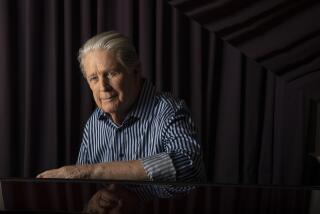I remember when rock was young ...
- Share via
IN 1957 AND 1958, rock ‘n’ roll took a tumble. Elvis Presley entered the Army. Jerry Lee Lewis was banned from the airwaves for having taken his 13-year-old third cousin as his third wife before his second divorce became official. Buddy Holly was killed in a plane crash, Little Richard got religion and Chuck Berry was arrested for “motor-vatin’ ” across state lines with an underage girl.
Understandably, this plunged American record companies into a state of serious consternation. Rock ‘n’ roll hadn’t been around very long, but its potential was already clear: When Presley entered and dominated the charts in ‘56, record sales rose by roughly $100 million from the previous year’s $227 million. The market: roughly 13 million teenagers.
But if the interruption of these rock ‘n’ roll stars’ careers was worrisome, it also provided an opportunity. After all, early rock ‘n’ roll had been a little unruly -- a little too dangerous, a little too black, a little too unpredictable. If profits were to be maximized, record companies realized, the market had to be consolidated and the product commodified.
“All the major labels had people on staff who produced records,” recalls songwriter and producer Richard Gottehrer, explaining that most of them were so incapable of re-creating rock ‘n’ roll that they had to say, “Oh, get those kids from down the street.”
As often as not, “down the street” was the Brill Building at 1619 Broadway in New York City and another, nameless building a stone’s throw away at 1650. Here, huddled in cubicles, songwriters such as Jerry Leiber and Mike Stoller, Doc Pomus and Mort Shuman, Burt Bacharach and Hal David, Neil Sedaka and Howard Greenfield, Carole King and Gerry Goffin, Barry Mann and Cynthia Weil, and Jeff Barry and Ellie Greenwich routinized the creation and production of rock ‘n’ roll in the late 1950s and early ‘60s.
They smoothed the rough edges of black R&B; performers to help them appeal to a white audience, and they roughed up white performers just enough to create a tousled titillation. Reining in the unruliness of rock ‘n’ roll made it safe for teenage America and profitable in the mass marketplace.
The music of the Brill Building era is often disparaged as a dormant period between the eruption of Elvis and the British invasion that the Beatles spearheaded. Bob Dylan has dismissed it as “pretty sleepy” and “filled with empty pleasantries.” Paul Simon once said that rock ‘n’ roll got “very bad in the early ‘60s, very mushy.”
Yet such “empty pleasantries” as “On Broadway,” “Save the Last Dance for Me,” “Walk on By,” “Breaking Up Is Hard to Do,” “Will You Love Me Tomorrow” and “Be My Baby” have proved extraordinarily perdurable.
King and Goffin’s “The Loco-motion” has been a Top 10 hit single as recorded by three different artists in three different decades. Mann and Weil’s “You’ve Lost That Lovin’ Feelin’ ” (written with Phil Spector) is the most frequently played song in the BMI catalog (which includes the Beatles’ greatest hits).
If these composers cranked out tunes on an assembly line, many of their widgets turned out to be masterworks of popular music.
Most of these writers were born in Brooklyn, virtually all of them were Jewish, and they enriched rock ‘n’ roll by widening its sphere of reference to embrace classical music (Bacharach studied with Darius Milhaud, Stoller with Stefan Wolpe), the Great American Songbook (Sedaka hung out with Irving Caesar, the lyricist of “Swanee” and “Tea for Two”) and Broadway musicals (“West Side Story” helped inspire Goffin and King’s “Up on the Roof”).
Infusing with the music of their elders the music of their own age, they added string arrangements. And, at the peak of Puerto Rican immigration to New York City, they gave a Latin twist to African American R&B.; Much of their music rocks or sways to a cha-cha, baion or bossa nova beat. An enduring appeal of these songs is their racial and ethnic integration -- and how irresistible they make such integration sound.
The British invasion, the advent of the singer-songwriter and the rise of black-owned record companies such as Motown brought the Brill Building era to an end in the mid-1960s, yet all these events owed considerably to the tunesmiths of midtown Manhattan. Goffin and King were models of songcraft to Lennon and McCartney. Records such as “Lovin’ Feelin’,” “Make It Easy on Yourself,” and “(You Make Me Feel Like a) Natural Woman” helped define modern soul music, black as well as blue-eyed. And the social consciousness of songs like “Uptown” paved the way for the protests of Dylan and his acolytes.
The music of the Brill Building and 1650 Broadway may not last, like the lovers’ bliss in Pomus and Shuman’s “This Magic Moment,” “forever ‘til the end of time,” but it reverberates to this day.
More to Read
The biggest entertainment stories
Get our big stories about Hollywood, film, television, music, arts, culture and more right in your inbox as soon as they publish.
You may occasionally receive promotional content from the Los Angeles Times.










